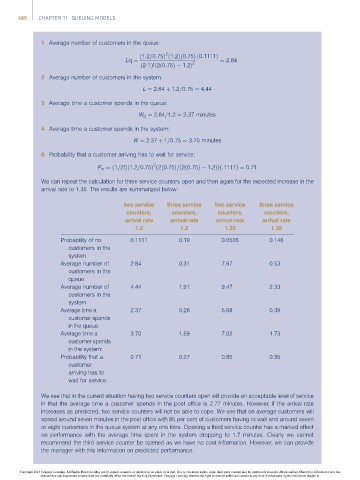Page 500 -
P. 500
480 CHAPTER 11 QUEUING MODELS
1 Average number of customers in the queue:
2
ð1:2=0:75Þ ð1:2Þð0:75Þ ð0:1111Þ
Lq ¼ 2 ¼ 2:84
ð2-1Þ!ð2ð0:75Þ 1:2Þ
2 Average number of customers in the system:
L ¼ 2:84 þ 1:2=0:75 ¼ 4:44
3 Average time a customer spends in the queue:
W q ¼ 2:84=1:2 ¼ 2:37 minutes
4 Average time a customer spends in the system:
W ¼ 2:37 þ 1=0:75 ¼ 3:70 minutes
5 Probability that a customer arriving has to wait for service:
2
P w ¼ð1=2!Þð1:2=0:75Þ ð2ð0:75Þ=ð2ð0:75Þ 1:2ÞÞð:1111Þ¼ 0:71
We can repeat the calculation for three service counters open and then again for the expected increase in the
arrival rate to 1.35. The results are summarized below:
two service three service two service three service
counters; counters, counters, counters,
arrival rate arrival rate arrival rate arrival rate
1.2 1.2 1.35 1.35
Probability of no 0.1111 0.19 0.0526 0.146
customers in the
system
Average number of 2.84 0.31 7.67 0.53
customers in the
queue:
Average number of 4.44 1.91 9.47 2.33
customers in the
system:
Average time a 2.37 0.26 5.68 0.39
customer spends
in the queue:
Average time a 3.70 1.59 7.02 1.73
customer spends
in the system:
Probability that a 0.71 0.27 0.85 0.35
customer
arriving has to
wait for service:
We see that in the current situation having two service counters open will provide an acceptable level of service
in that the average time a customer spends in the post office is 2.77 minutes. However, if the arrival rate
increases as predicted, two service counters will not be able to cope. We see that on average customers will
spend around seven minutes in the post office with 85 per cent of customers having to wait and around seven
or eight customers in the queue system at any one time. Opening a third service counter has a marked effect
on performance with the average time spent in the system dropping to 1.7 minutes. Clearly we cannot
recommend the third service counter be opened as we have no cost information. However, we can provide
the manager with this information on predicted performance.
Copyright 2014 Cengage Learning. All Rights Reserved. May not be copied, scanned, or duplicated, in whole or in part. Due to electronic rights, some third party content may be suppressed from the eBook and/or eChapter(s). Editorial review has
deemed that any suppressed content does not materially affect the overall learning experience. Cengage Learning reserves the right to remove additional content at any time if subsequent rights restrictions require it.

